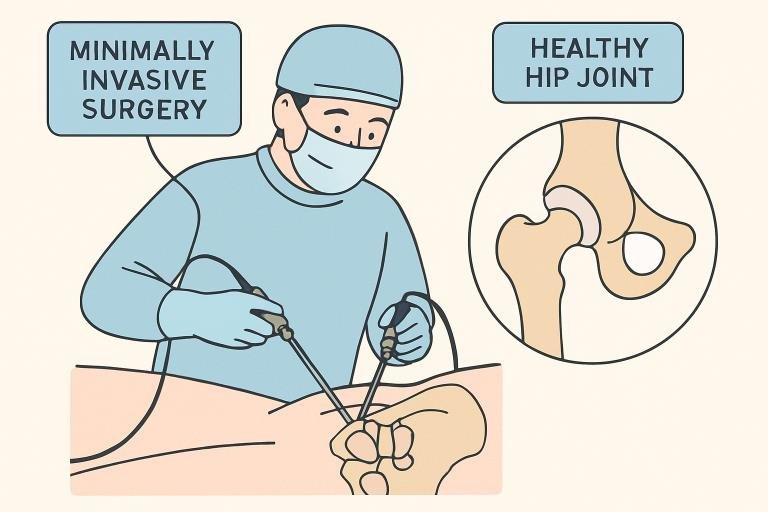Key Takeaways
- Minimally invasive hip arthroscopy techniques significantly decrease recovery time and patient discomfort.
- 3D imaging and MRI advancements allow personalized preoperative planning for precise intervention.
- Biologic treatments like platelet-rich plasma (PRP) harness your body’s healing potential for enhanced outcomes.
- Custom 3D-printed implants and robotic-assisted procedures ensure optimal anatomical fit and accuracy.
- Updated rehabilitation protocols speed up recovery and improve the return to daily activities.
Hip preservation surgery is rapidly evolving with pioneering techniques designed to keep patients active while maintaining their natural hip joints for as long as possible. Advances are aimed at maximizing surgical accuracy, minimizing invasiveness, and promoting faster healing—giving many people new options to treat hip dysfunctions before resorting to more invasive procedures like hip replacement surgery.
Thanks to technology-driven breakthroughs and a deeper understanding of hip biomechanics, surgeons can now employ minimally invasive methods, incorporate advanced imaging, and use biological solutions that boost the joint’s natural healing response. These approaches reduce pain, improve outcomes, and can delay or sometimes even eliminate the need for hip replacement surgery in appropriate candidates.
Minimally Invasive Surgical Techniques
The trend in hip preservation is overwhelmingly toward less invasive procedures. Hip arthroscopy, in particular, is now the gold standard for treating labral tears, bone impingement (FAI), and cartilage damage. Surgeons operate through tiny incisions, using specialized instruments and cameras to repair soft tissue and shave down abnormal bone growths. Notably, recent advances in post-less hip arthroscopy have further reduced complications such as nerve numbness and allowed even safer outcomes.
Key Benefits:
- Shorter and more comfortable hospital stays
- Reduced postoperative pain and less reliance on narcotics
- Minimal scarring and quicker resumption of normal life
- Lower risk of complications typically associated with open surgeries
Want to learn more about how hip arthroscopy is revolutionizing labral tear repair? Check the resources provided by the Hip Preservation Society.
3D Imaging and Preoperative Planning
Improvements in imaging play a central role in modern hip preservation. High-resolution MRI and 3D modeling software enable surgeons to visualize subtle abnormalities, accurately diagnose problems like hip dysplasia, and meticulously plan interventions. By creating a virtual 3D replica of the joint, these tools ensure that procedures are tailored to each patient’s exact anatomy.
Key Benefits:
- Greater surgical precision and confidence
- Lower risk of complications due to improved anatomical understanding
- Long-lasting results by addressing underlying issues thoroughly
Biologic Treatments & Regenerative Medicine
Today’s hip preservation surgery is not just about fixing mechanical problems, but also about boosting the body’s innate potential for repair. Platelet-rich plasma (PRP) therapy and stem cell injections use the patient’s own cells or blood components to stimulate healing in injured tissues. These biologic solutions can be performed as standalone treatments or adjuncts to surgery.
Key Benefits:
- Minimally invasive with low risk of side effects
- Can reduce or delay progressive joint degeneration
- Improved healing and reduced inflammation following surgery
Customizable Implants and Prosthetics
Patients presenting with severe bone deformity or advanced dysplasia may require implants. Technology now allows for the customization of these implants via 3D printing to fit each person’s anatomy. Such personalized solutions are especially valuable in periacetabular osteotomy (PAO) and hip resurfacing, greatly enhancing joint alignment, stability, and function.
Key Benefits:
- Improved implant fit and long-term durability
- Reduced surgical complications
- Better restoration of movement and strength in the hip
Computer-Assisted and Robotic Surgery
Robotics and computer navigation bring a higher level of accuracy to surgical procedures. These tools allow for live intraoperative feedback and highly precise bone alignment, implant positioning, and soft tissue handling. Patients benefit from more exact reconstructions with less risk for misplacement or residual deformity.
Key Benefits:
- More consistent and accurate results between cases
- Lower risk of postoperative complications
- Optimal joint function after recovery
Enhanced Postoperative Rehabilitation Protocols
Cutting-edge rehabilitation after hip preservation surgery is a cornerstone of successful recovery. New approaches involve wearable tech for activity monitoring, custom-tailored physical therapy, and comprehensive education to empower patients at every stage. These programs are designed to accelerate healing, optimize joint function, and prevent future issues.
Key Benefits:
- Faster return to everyday activities
- Less pain and improved joint mobility
- Lower risk of complications like stiffness or weakness
Emerging Non-Surgical Interventions
While surgery is transforming, non-surgical options remain essential for managing early hip pain and dysfunction. Advanced physical therapy, biologic injections, and strategic lifestyle modifications can reduce discomfort, maintain joint motion, and preserve quality of life—delaying or sometimes preventing the need for surgery.
Key Benefits:
- Minimal downtime and recovery
- Effective in treating mild to moderate hip conditions
- Often used in combination for personalized care plans



